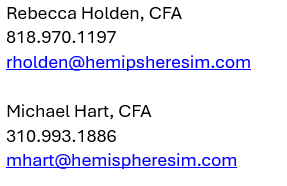Introduction to Market Capitalization
Definition of Market Capitalization: Commonly called Market Cap, refers to the market value of a company’s equity. Market Capitalization is the product of the current share price by the number of shares outstanding. Market cap fluctuates with daily price movements in the stock price. The methodology to calculate market cap for Global Equity funds and Domestic funds is identical.
Definition of Float-adjusted market capitalization or free-float market cap. Float-adjusted market capitalization is the product of the company’s stock price and the number of shares trade publicly. Locked-in, or inactive shares are not traded in the open market. Examples of locked-in shares may include shares held for the benefit of company insiders or unexercised options.
Major market cap weighted indices like the S&P 500 use the float-adjusted market cap method. Float-adjusted market cap readily reflects market trends as it examines shares that are trading daily. There is an inverse correlation between the size of free float and volatility. Larger free-float companies tend to be less volatile because of the volume of trading that occurs during a typical day. This would seem to indicate that large cap stocks tend to be less risky.
Categories of Market Capitalization
The size of a company’s market cap determines Companies are categorized by the size of their market capitalization
- Mega Cap companies have market cap greater than $200 Billion.
- Large Cap companies generally range between $10 Billion and $200 Billion in market cap.
- Mid Cap companies generally range between $2 Billion to $10 Billion.
- Small Cap generally range from $200 million to $2 Billion.
Significance of Market Capitalization in Global Equities
Market Cap is simply the product of shares outstanding and the market price of the common stock. Market cap categorizes companies by size to compare similarly sized firms within a respective sector. Larger cap companies theoretically have lower risk than smaller companies but this is not an absolute rule. Any potential investment candidate requires extensive due diligence and analysis irrespective of market capitalization.
Hemispheres Investment Management is an multi-cap fund. Through diligent analysis, Hemispheres Investment Management selects the most attractive valued stocks from the over 45+ investable stock markets. Hemispheres is a bottom-up manager, meaning that its process for security selection begins at the individual company level; utilizing a disciplined approach that includes investing in companies that are fundamentally attractive. Fundamental analysis includes an analysis of market position, the balance sheet, profitability and valuation. Global Equities has a universe of over 10,000 companies with a market capitalization more than $1 billion to invest in compared to 2,000 + in the United States. Hemispheres reduces investor risk by buying undervalued stocks from the standpoint that fully valued or overvalued stocks are riskier considering that their return is vulnerable to the movement of stock market indices or a decline in fair market value.
Market Capitalization Categories
Large Cap: Many investors view larger companies as lower risk because these companies are often dominant companies within their industry with long-established and well-known product lines and market share. Large firms normally have stable earnings, cash flow and dividend growth. Rotation by fund managers into higher weightings of large cap stocks can occur in anticipation of recession where the large cap firm’s margin of safety provides investors with a safe haven during a difficult economic environment.
In terms of demographic suitability, because of larger daily trading volumes, an investor nearing retirement who wants to sell stock to fund living expenses is viewed as having a better chance of liquidating shares of a large cap stock at favorable prices. The downside to holding large cap companies, however, can be that eventually larger companies grow at slower rates which affects the premium investors are willing to pay for the stock. Despite lower growth rates, the stable and growing dividend yield that many of these companies provide can make these attractive investment prospects.
Mid Cap: Mid-cap companies are firms that are perceived to have, or expected to have, higher growth than a large cap company. The company may have a proprietary product that will result in improved competitiveness or market share in a specific industry. Mid-cap companies are also believed to have less risk than a small cap company. Often, this lower risk centers on greater access to capital to fund growth than a small cap firm. Once again, fundamental analysis is critical to determine the suitability of adding a specific stock to the fund.
Market capitalization does not tell the investor if a company is growing or getting smaller. It is a static measurement at a moment in time. A firm that was once a large-cap company may be in decline or it may have experienced an operating challenge that resulted in a stock price that now, when multiplied by outstanding shares, qualifies as a mid-cap firm instead of a large-cap firm.
Small Cap: Many small cap companies operate in newer life-cycle industries (such as artificial intelligence for example) or in a niche market (such as a biotech entity). These firms may have very promising products, however they may not be profitable, and access capital may be limited. The relatively limited resources of small companies can potentially make them more susceptible to a business or economic downturn. Small cap firms in promising sectors may be subject to intense competition. The attraction of small-cap stocks is the potential for significant growth in revenues and earnings and therefore rapid appreciation of the share price to long-term investors who can tolerate stock price volatility. Of the three main classifications of market capitalization, small cap stocks have the highest risk generally.
Correlation Coefficients
| S&P 500 | S&P 400 | Russell 3000 | |
| Large Capitalization – S&P 500 | 1.0 | 0.91 | 0.86 |
| Mid Capitalization – S&P 400 | 0.91 | 1.0 | 0.96 |
| Small Capitalization – Russell 3000 | 0.86 | 0.96 | 1.0 |
Statistically, a correlation factor of less than 0.7 means that adding a different security or index to the portfolio offers diversification benefit. As shown above, the domestic indices are highly correlated. A high correlation level means that these indices generally move in the same direction. A low or negative correlation level means that the securities or indices move in opposite directions, offering diversification benefits.
Hemispheres provides diversification benefits to clients in two ways. First, while the indices are highly correlated, the individual stocks held within the index may not be. Hemispheres’ process selects stocks based upon financial fundamentals and valuation at a specific firm. Second, Hemispheres is a global equities manager. The MSCI Emerging Market correlation to United States markets is 0.6 and highlights that the relative movements between the S&P 500 and MSCI Emerging Market Index provides investors with opportunities to buy or sell into international stock markets in which prices move in a differing direction from the U.S. markets. In other words, adding Emerging Market assets to the S&P improves portfolio diversification.
Strategic Value of Market Capitalization Analysis
The relationship between Gross Domestic Product (GDP) and Market Cap enables analysts to assess market risks. This indicator assists managers individualize client portfolios. GDP measures the total value of all goods and services produced within the country’s border during the quarter or year. Government and consumer spending, investment and exports all factor into GDP. GDP growth is an indicator of economic vitality.
The stock market composition is critical in assessing market cap. Factors such as the number of companies with publicly listed shares and the relative size of market cap can affect the balance between GDP and market cap. Stock markets where the risk premiums for stocks are low may have a thriving stock market and high market caps. In this instance, market capitalization could be greater than GDP. It is possible to assess boom and bust cycles by analysis of the GDP/Market Cap balance.
During the late 1990s, the US stock market experienced the dot.com bubble. The stock prices of internet related companies saw exponential growth. The market capitalization of these companies became very large despite consistent and persistent operating losses. Because the financial fundamentals did not support the market prices of the securities, the market crashed. Likewise during periods of recession and declining GDP, market cap of individual companies can shrink.
Hemispheres Investment Model and Allocation Strategy
Hemispheres investment model provides for a thorough evaluation of company fundamentals and valuations; thereby investor risk is reduced. Hemispheres offers balanced, multi-cap portfolios.
Hemispheres Investment Management will work with you to evaluate your financial goals, risk tolerance, and time horizon. An optimal Global Equities portfolio is diversified by sectors, countries, regions and balanced by market capitalization. Our goal is to reduce investment risk and create an investment policy that is supportive of your financial goals.
Conclusion
We recognize that individual and institutional investors alike may be new to investing in Global Equities. There are complexities and nuances associated with investing in various markets that require expert guidance. Hemispheres Investment Management’s team of seasoned professionals have a 35-year track record of successful investment strategies.
Please contact Hemispheres Investment Management for a free consultation. We offer individualized guidance and strategies that can help you or your business optimize your investment policy. We can assist you achieve your investment goals. Book a meeting







